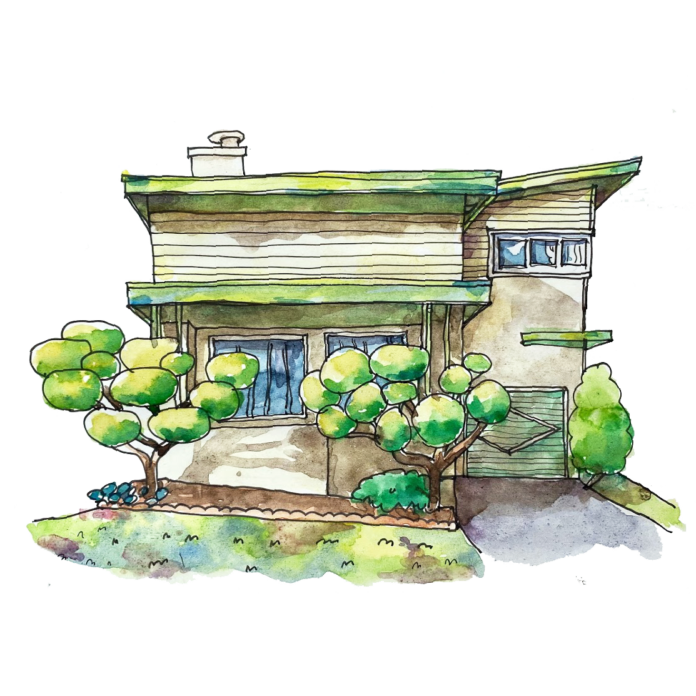Conversations with San Francisco’s window workers.
by Nikki Collister
A wide picture window overlooking the intersection of Fulton Street and 6th Avenue, double-hung windows on either side, crowned with a graceful arch of three glass panes. This was my favorite thing about my 1920s-era Inner Richmond apartment, the one persistent image in a catalog of fading memories. From my vantage point on an IKEA armchair next to that wall-length window, I’d watch cyclists and roller skaters gliding into Golden Gate Park, trailed by couples with picnic baskets and families with dogs. Lazy Sunday mornings would stretch into afternoons, sending westerly sunlight streaming across the hardwood floors.
Not surprisingly, when my dad visited the apartment, the window was the first thing he noticed. It was original, he told me, pointing out the wavy glass that gave the entrance of Golden Gate Park across the street a dreamlike aura, Monterey cypress trees bulging and constricting through the imperfections. With hands roughened from years of working with windows just like this, he showed us the tiny suspended pockets of air, “seeds” he called them, inconsistencies born of turn-of-the-century glassmaking.
My dad installed windows for a living. It was a job that had a tendency to seep into everyday life, peppering his observations wherever we went. On childhood trips to San Francisco, I became familiar with neighborhoods in this way. Haight-Ashbury was a showy display of Victorian turrets and curved glass, SoMa a collage of brick and steel and reflective blue-tinted surfaces. The Sunset District unfurled like an enormous quilt of pastel stucco and square glass panes stretching all the way to the ocean.
Both of my parents knew the neighborhoods well, having lived and worked here from 1971 to 1989. But my dad’s perspective of the city was one of intricate detail. Each time we passed an intersection, there was something he couldn’t resist pointing out: a decorative cornice maybe, or an Edwardian bay window with artfully painted trim. My young mind absorbed few of the details, instead filling with wonder as I stared up at San Francisco’s sophisticated facades.
When I was growing up, the fact that my dad was a “window man” was a simple truth, something I never questioned or considered. He’d leave the house early each morning in his work truck, stopping at the warehouse before traversing the outer reaches of San Diego County, his indestructible Thomas Guide, containing the addresses of every job he needed to go to, always within arm’s reach. On late afternoons, after coming home for the day, he’d sit at his old wooden rolltop desk to make phone calls, setting up appointments for measurements and letting customers know when he’d be there to install their windows.
It wasn’t until I moved to San Francisco after college that a curiosity about his profession started to surface. Walking up the hill from the Muni stop to my tiny studio on Frederick Street, I started to pay attention to the intricacies of every building, wondering idly what Dad would have to say about each one. The question has quietly followed me through four apartments and eight years: What could I learn from seeing San Francisco as he did, through the eyes of the window workers who framed our views of the city?
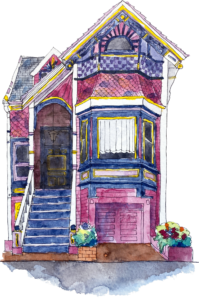
A Warehouse on Bayshore Boulevard
Near the intersection of 101 and 280, where cars hum across the freeway behind home appliance stores and flooring depots, sits Ames-Billingsley’s former warehouse, a nondescript building with a graffitied roll-up steel door. It was once one of many well-respected window shops in the city, founded by “Old Man Ames” back in 1958 and later run by his son Brad.
My dad started working at Ames- Billingsley in 1979, on a recommendation from his old buddy Bill Rowan, who’d taken up a contract job there. Both my dad and Bill came from the Midwest, their paths having intersected unexpectedly when they were drafted for the Vietnam War and ended up in the same barracks. They became quick friends, Bill’s boisterous personality the perfect foil for my dad’s calm, careful demeanor. Since leaving the army, they’d both ended up in San Francisco, trading their fatigues for jeans, plaid flannel, and matching full beards.
In the factory on industrial Bayshore Boulevard, workers cut and prepared the windows that would be carted on the backs of pickup trucks to each day’s jobs. Window installers, like my dad and Bill, worked “out in the field,” their job sites scattered across the city and its suburbs. For Dad, the profession was a natural fit. It required physical skill and handiwork—traits instilled in him from generations of Kansas farmers. But more importantly, it appealed to his deep-rooted interest in the people whose homes he stepped into.
“Bankers, movie producers, older folks, none of them cared that I was a long-haired hippie putting in their windows,” he told me in one of our recent quarantine-prompted phone calls. Inside San Francisco’s storied houses, he could almost always develop a rapport with customers who were put at ease by his amicable Midwestern manner.
For larger jobs, the installers worked in pairs. My dad was often teamed up with his Cuban co-worker Edgardo, and although they didn’t speak each other’s language, they realized they both knew enough elementary French to communicate in broken “Comment allez-vous?” and “Je vais bien”s.
These laborers passed through the homes of San Francisco’s wealthiest and poorest neighborhoods, the sound of distant sirens and the exhaust of Muni buses wafting into each home as they diligently removed each window and replaced it with another.
Most of the window men, my dad included, hadn’t necessarily planned to stay for long at the Bayshore shop. They were accustomed to working odd jobs for no more than several months at a time. But here they found steady work, bolstered by a sense of camaraderie and craftsmanship. Edgardo stayed for six years, his English becoming proficient enough to land him his next job as a postal worker. Bill was employed by the company on and off for 13 years. As for Dad, getting into the window industry in 1979 was the beginning of a 30-year career.
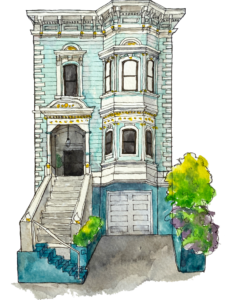
Ode to the Wood Window
Not too far from Ames-Billingsley’s old warehouse, Mike York sits alone in his office, giving me a crash course in window production over the phone. It’s April 2020, and business is slower than usual for York and his team at Ocean Sash and Door. San Francisco’s shelter-in-place order has halted all construction projects, and apart from the occasional emergency replacement, the company’s services are not in high demand. Still, I get the feeling that even in the busiest of times, York would’ve made time to chat. (“Of course, this is my favorite subject,” he had replied when I first reached out for an interview.) Ocean Sash and Door has been in business since 1880—passed down through two families and four generations—making York the gatekeeper of 140 years’ worth of San Francisco window history.
I listen to York describe a new type of wood being used in window construction, called accoya. The wood is put into a reactor and injected with a vinegar derivative, he explains, a process that essentially changes its DNA. “The result is a wood that will not absorb water. It will never rot,” he says. For anyone who’s had to replace thousands of windows damaged by rain and wind, this is a breakthrough. As an added bonus, accoya’s neutral color—a pale taupe that can be stained to match the rich hues of cedar or mahogany—makes it extremely versatile.
Wood has long been the material of choice for San Francisco windows, the bones keeping them in place. Examine a basic double-hung window from a Victorian home and you’ll find two single panes of glass framed by redwood—cut from Northern California’s once-abundant redwood forests—each secured on a track inside a larger frame. To the side, a system of cords, pulleys, and weights allows each sash (the moveable sections of the window) to slide up and down, opening the window from the top and bottom. It’s a centuries-old mechanism, the interior weights lifting the lower sash like magic.
Construction of a window like this requires a unique kind of craftsmanship. Knowing how to install and maintain it, York assures me, is equally important. Installers often need to fit a square sash in a not-quite-square opening, adding shims and sanding the sides to make it level, plumb, and square. Without proper sealing putty and weather stripping, a double-hung window will quickly become drafty and ripe for wood rot.
In our conversation, I learn how window technology has evolved over the decades. In the ’70s and ’80s, aluminum emerged as an economical choice for new and replacement windows, offering a lightweight modern look compared to traditional wood. By the tail end of the 1980s, vinyl became the new standard: a practical, synthetic option that, if you paid a little extra, could be convincingly made to match the design of any house. Glass had evolved too; today’s double-glazed, noise-reducing glass is a far cry from its single-paned, wavy predecessor.
Aluminum windows hit their peak during my dad’s window career in San Francisco, although he and many others preferred the natural look of wood. In one of his most retold stories, he was assigned to replace windows in Lawrence Ferlinghetti’s North Beach apartment in the early ’80s. Ferlinghetti wasn’t home during the job—“I’d imagine he was probably at the bookstore,” Dad said, referring to City Lights, which Ferlinghetti co-founded. However, the renowned poet had left a strongly worded note to the landlord on his desk, condemning the choice to replace the original varnished wood windows with metallic aluminum.
Dad saw his point. Unable to bear discarding the windows from Ferlinghetti’s apartment, he took them home in the back of his truck, adding them to his growing collection of antique windows in the basement, stacks of stained glass and delicate Craftsman muntin he kept for years.
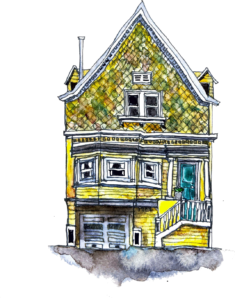
Architecture in the Avenues
While my dad accumulated relics in basements and garages, Bill Rowan used his time out in the field to build up an encyclopedic knowledge of local streets and architecture. Decades later, he continues to fact-gather on daily treks, with the goal of walking every block in San Francisco. “I’ve already done the entire Sunset and the entire Richmond, up and down, back and forth,” he tells me by phone during the shutdown. He talks about the neighborhoods in his own shorthand. A house on 34th Avenue between Lawton and Moraga, for example, is “in the mid-30s between L and M.”
If you’ve spent much time in the Outer Sunset, Bill’s home for the last five decades, you’ve probably seen him on one of his walks: long white hair and beard, thick-rimmed glasses, a worn straw hat. He may have passed by your house and, if you were in the front yard, asked what year it was built. “1908? I would’ve guessed 1915,” I saw him remark to one homeowner. “You know, the front porch on your house is really unique for that era.”
Hiking through the gridded suburbia of the west side, he’s had plenty of time to add to his mental storehouse. When there’s not a homeowner outside to talk to, he’ll reminisce. Certain blocks stir up recollections of the neighborhood’s unique architectural features, the ones you wouldn’t know existed unless you had access to them, as Bill did as a window installer. He fondly recalls memories of the “little passages and terraces in the middle of a house where you could look up and see the sky.”
Such details are the work of Henry Doelger, one of the city’s most famous homebuilders and a familiar name to every window expert I’ve talked to. From the late ’30s through the ’50s, Doelger’s modern stucco houses sprouted up in neat lines on top of the sandy dunes of the Sunset District, styles advertised in catalogs with names like The Styleocrat and The Nantucket. They were produced with impressive efficiency, crews coming in quick succession to lay the foundation and erect the framing, followed by walls and interiors, and finally, the windows. To prevent houses of similar styles from looking exactly the same as their neighbors, a different window design was featured over each garage: some square, some arched, others triple-arched. Cookie-cutter houses, with variations in icing.
Further north, in the Richmond District, Bill’s walks retrace the architectural history of Fernando Nelson, one of San Francisco’s most prolific homebuilders—and the founder of Ocean Sash and Door. Nelson erected hundreds of houses between 2nd and 16th Avenues at the turn of the 20th century, earning him the nickname “the Father of the Richmond District.” Redwood reigned supreme in Nelson’s houses, from their inner construction all the way down to their signature design element: a series of painted redwood “donuts” arranged in a row above the entryway.
The details of Doelger’s and Nelson’s original houses have largely been preserved thanks to conscientious homeowners and San Francisco’s strict residential design guidelines. For homes over 40 years old, I learned from Mike York, all street-facing window replacements must be an exact replica of the original. As a result, restoration jobs are common for Ocean Sash and Door. In the shop, workers source the same type of wood as the original—and even re-create the same wavy glass—to craft a convincing replica window. The replica is then fitted with a modern balance system and weather-stripping, bringing it up-to-date with California energy efficiency standards. Occasionally, York will get a job working on one of Fernando Nelson’s long-lived redwood houses. “A hundred years later,” he marvels, “we’re replacing windows originally built by the founder of our company.”
Back at home in the Outer Sunset, Bill Rowan continues his daily walks. Homeowners don’t offer him a peek inside their houses like they used to, but they still share the history that they know: year of construction, architect, tidbits about previous residents. “I don’t write anything down. I probably should,” Bill muses. Like my dad, he’s a slow typist, much more content to tell stories in person. Our conversation has barely scratched the surface of his mental catalog, but for now, I eagerly document what I can.
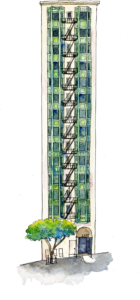
Tools of the Trade
From the ground looking up, the tower at 2238 Hyde Street is a mini skyscraper: a dizzying column of bay windows and fire escapes, the tallest building on an already-tall hill. In 1983, Bill and my dad found themselves in the opulent 14th-story penthouse of the residential tower, replacing the north windows that overlooked the Marin Headlands and Angel Island. The two of them, in their jeans and jackets, removed the existing windows from inside and deftly replaced them as they’d done countless times before, taking turns leaning outside—100 feet above the neighboring rooftop—to caulk the exterior seam of each top sash.
They’d learned to handle glass with the expertise and respect it demanded, positioning each sash with care, cutting and inserting wood shims to fill the gaps between frame and wall. After each job, they tied the old windows securely to the pickup rack, lest anything come loose on a particularly steep hill. Like the other men of Ames-Billingsley, they had met dizzying heights, earthquakes, and even the stray bullet in gang territory with steadfast aplomb. Whatever dangers the work might hold, it was better than many alternatives: war in Vietnam, political unrest in El Salvador, prison in Cuba.
Their previous life experience occasionally provided a common ground with the people whose homes they entered. For Bill, it was the old-timers he met on jobs in Daly City, men in their 80s who’d been in the Philippines during World War II. On those days, he wasn’t just a contractor but a fellow war veteran, recounting stories of life and death over homemade lumpia during lunch breaks. Was it common for customers to open up like that? Not always, Bill says. “But these guys wanted to talk. They were lonely, and they wanted to tell their stories.”
By the spring of 1989, I’d come along, and my dad had made the decision with my mom to move down to Southern California. On his last day at work, the men at the window shop all gathered for a photo in the loading zone of the warehouse. In the snapshot, my dad is wearing glasses and a beret, and his beard is much more clean-cut than the one he’d sported 10 years prior. Made up of immigrants, transplants, and Bay Area natives, the smiling group stands surrounded by cardboard, glass, and aluminum frames: the tools of their common trade.
Since then, the number of window workers in San Francisco has dwindled. In the factories, new machinery and automated processes have eliminated jobs. The 2008 recession decimated independent window shops across the country. Those that made it through the recession had to downsize; many, like Ames-Billingsley, would close soon after.
Ocean Sash and Door has become a leaner operation in recent years, one of only four window production companies left in the city. Business nearly slowed to a standstill during San Francisco’s stay-at-home order in the spring of 2020. Mike York knows that the need for windows isn’t going anywhere, but he wonders who will be left to install them. “I don’t see anyone new coming up. It’s just us old folks left.”
. . .
Two years ago, I moved from the Richmond District to a midcentury apartment on the edge of Bernal Heights. I instantly found a new favorite view from my apartment’s south-facing windows, looking out past the tops of telephone poles and palm trees at the Excelsior hills. I especially love the scenery at dusk, the time of day when people start flicking on their lights inside but haven’t yet closed their curtains, creating a hillside dotted with glowing windows and distant stoplights.
In that way, I am my father’s daughter. When I first asked my dad, now retired, if there were certain parts of the city he enjoyed working in the most, the short answer was “anywhere with a view.” Coming from the plains of Kansas, he was particularly captivated by San Francisco’s hills, each one offering a different angle of the city he’d come to call home. The longer answer unfolded with each conversation. Turns out, some of the most memorable views weren’t from a hill at all. They were of Lawrence Ferlinghetti’s typewriter in North Beach, or of a wife comforting her husband as he recounted memories of World War II, or of a motley crew of men gathered together for a picture in the window warehouse.
So, too, has the scenery shifted from my window. Sheltering in place, I find myself gazing not at the distant hills but instead at the tops of succulents sitting on a neighbor’s windowsill, or at a teddy bear peeking out of a child’s bedroom. During a neighborhood walk on a particularly lovely day, I see a handwritten sign taped to one window: “Apart but not alone.” I try to imagine its invisible author who, like 880,000 other San Franciscans, is likely spending more time than they’d ever thought possible at home—becoming intimately familiar with their own private view of a city stuck in time, waiting for the world to restart.
The San Francisco I saw through distorted antique glass on Fulton Street nearly a decade ago feels like a different city. It’s easy to say that today’s view is bleaker—though that perspective may be skewed by a global pandemic and self-isolation. But having listened to the stories of San Francisco’s window men over the course of many phone calls, I feel like I’ve been given an invitation to see things through a different lens, permission to delve into the history of a nearby building or simply appreciate the mint-green trim around a neighbor’s sunroom window. In a way, there’s even more to see now. When I step outside on my daily walk, the city seems more vibrant than ever, its walls thrumming with history, layers of stories in the woodwork waiting to be told.♦
Nikki Collister hails from Southern California but considers herself a San Franciscan at heart. She holds a degree in ethnomusicology (a qualification that may or may not serve a purpose someday) and works as a product manager in the travel industry. In her spare time, she writes for Hoodline and manages her cat Cooper’s Instagram account.


